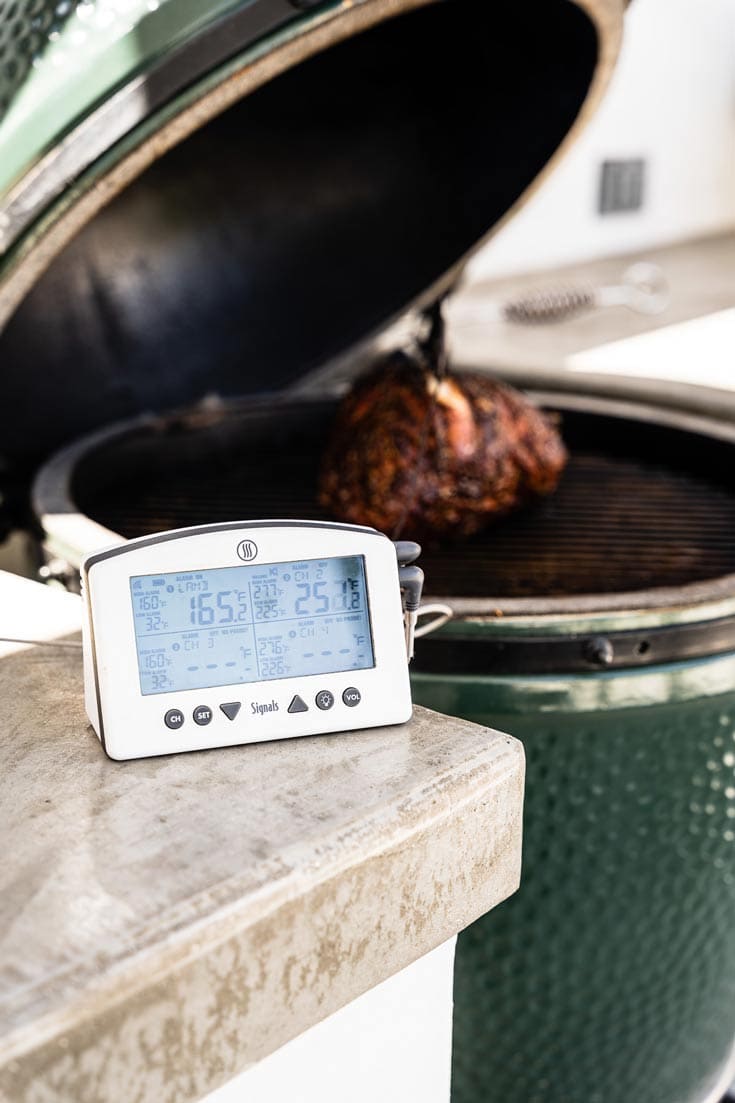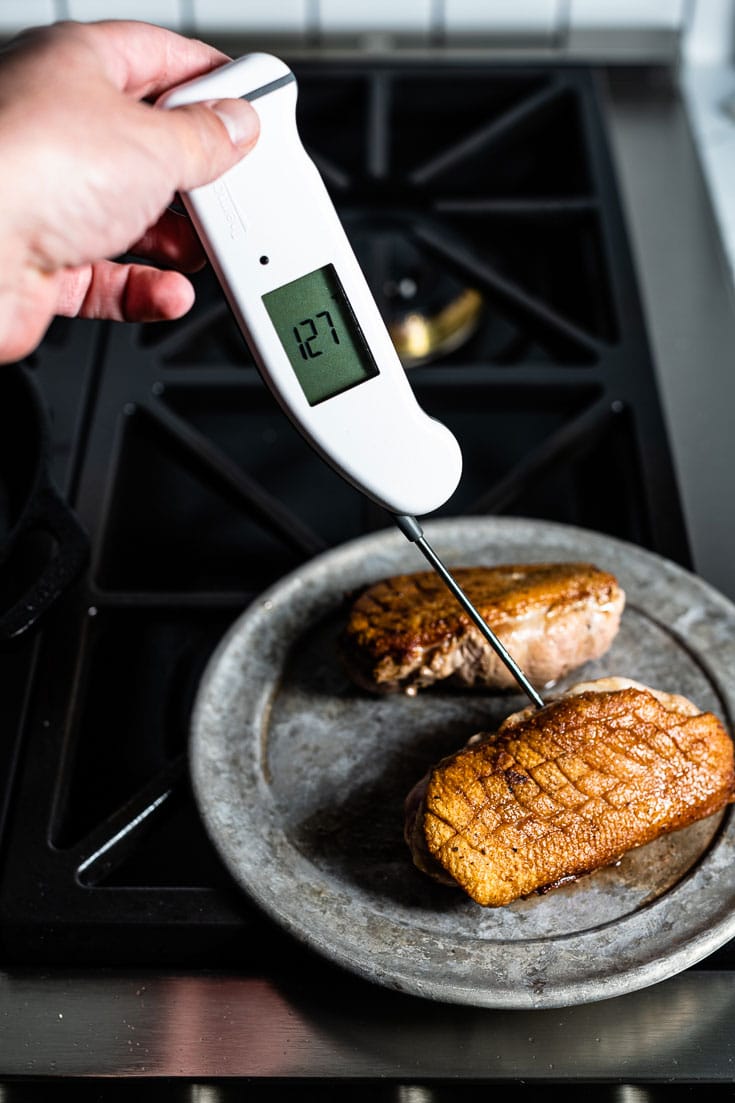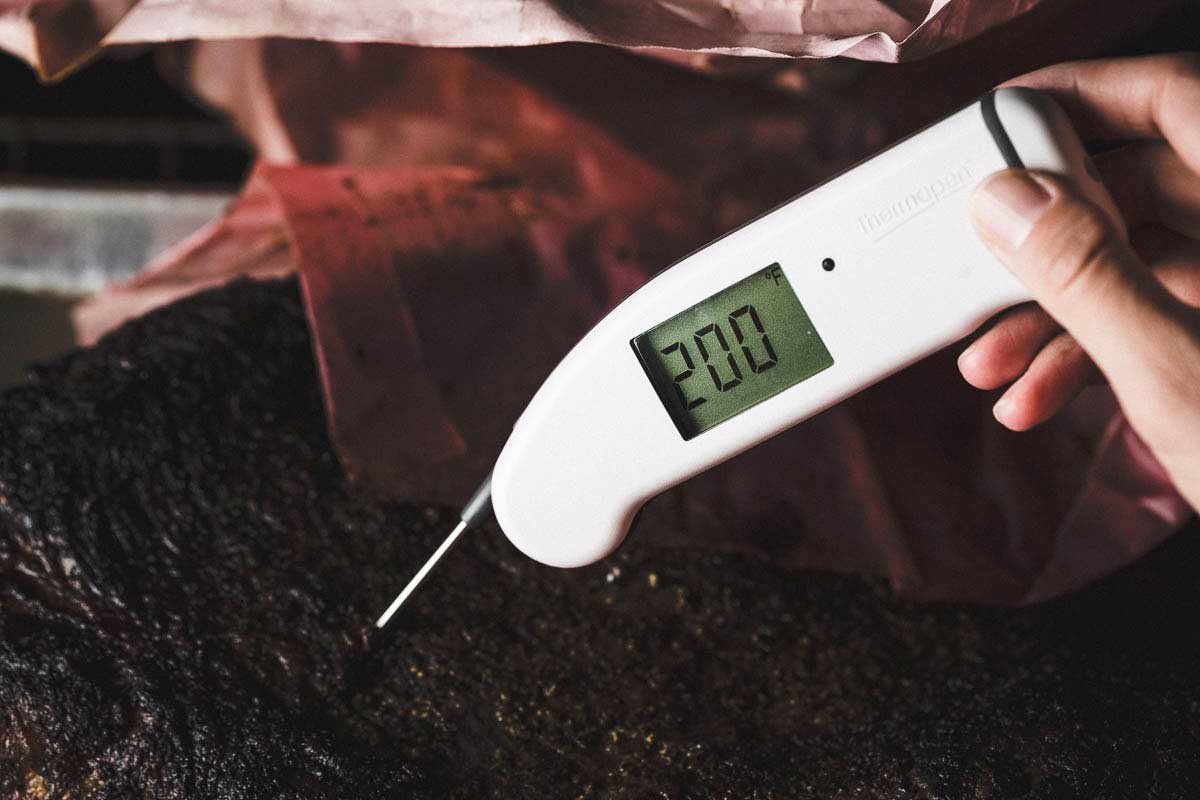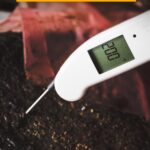Want to bring your cooking to a whole new level and make getting perfect results easier at the same time? Try the cooking-to-temperature technique for the perfect finish, every time.
As nice as it is to think you know how long something will take to cook, cooking by time is much less precise compared to cooking by temperature. Simply following the time on a recipe won’t necessarily lead to the results you want. And it may be less common for non-meat recipes to have a temperature listed, but once you’re looking, you’ll see it: Think of baking bread, frying oil, making candy, heating poaching liquid or cooking egg dishes.
Using the humble probe thermometer is freeing. It eliminates guessing, it ensures perfect doneness, and it just makes cooking easier. Once you start doing it, there’s really no going back.
The Problem with Cooking by Time
Cooking to a recipe’s specific time and oven (or smoker) temp is a recipe for inconsistent results and consistent disappointment.
Let’s say a recipe for roasting a whole chicken says to roast it for 1 1/2 hours at 350° F. Your chicken is on the smaller side, and your oven’s temperature isn’t exactly accurate and is 50 or even 100 degrees above what it reads (not at all uncommon).
Your chicken will be a dry, overcooked and disappointing. The opposite could also happen, and you have an undercooked mess on your hands. You will think you did something wrong, or the recipe was wrong.
The solution to the problem is simple. Eliminate time from the equation, and just focus on temperature. That’s really all that matters, and it simplifies things immensely.
Cooking without a high-quality thermometer is like flying blind. You don’t really know what is going on deep in the dish. Using internal temperature is exact, and it eliminates guessing.
Cooking to temperature can change everything. It gives consistent, accurate results, eases the mind and leads to close-to-perfect results.
What Is Cooking to Temperature?
Cooking to temperature is when you cook to a specific internal temperature, rather than relying on a time or visual cues or other ways to determine when something is done. Aiming for a specific internal temperature helps to ensure the food is safe to eat and is at optimal doneness for the desired results.
The technique of cooking to temperature requires a probe thermometer, which is inserted into the thickest part of the meat or dish to measure its internal temperature. A quality thermometer will give quick and accurate readings.
Benefits of Cooking to Temperature
- Consistency – Cooks the same, every time. Regardless of the size of the piece of meat or the temperature at which you are cooking.
- Food safety – Makes sure your food gets to a safe temperature that will kill bacteria.
- Optimal texture – When the food is cooked to the right temperature, the texture will be just right. It’s not just meat, even baked potatoes have an optimal internal temperature.
- Faster cooking (sometimes) – You won’t be opening the oven or smoker to constantly check for doneness, which lets hot air out and slows down the cook.
- Less stress – No guessing. My favorite reason.
- Freedom – When you eliminate guessing, you are free to not worry about how long something will take and concentrate on other tasks.
The Variables of Cooking Time
There are numerous variables in cooking that change how long something will take to cook. Being aware of these variables makes it easy to understand why using time is not a great way to cook, since each situation is unique.
- Size – The thickness, shape and fat content of meat play a big role in how it cooks.
- The starting temperature of food – A dish or meat right out of the refrigerator will be much colder than if you let it temper (come to room temp). It will also take longer to come up to temperature when it is cool in your kitchen.
- The weather – Humidity, the outside temperature and wind all play a role.
- Altitude – Higher altitude will cause foods to cook more slowly.
- The cooking vessel – Different materials conduct and distribute heat differently.
- The oven, smoker or grill’s thermometer – If it came with a thermometer, it is most likely off. The only question is how far off.
- Thermometer accuracy – Probably the most important when you cook to temp. Both the thermometer that measures the temperature of your smoker or oven, and also the thermometer that you use to measure the internal temperature, need to be really accurate. Your cooking accuracy is only as good as your thermometer, which is why high-quality thermometers are worth investing in.
- Cooking method – Direct versus indirect heat.
- Your cooker/oven – The way it moves air, how insulated it is, how consistent it maintains the temp. A convection oven will circulate the hot air, cooking about 25% quicker than without convection.
- You – How often you open the lid of your smoker or door to the oven. If the lid is open, the hot air escapes and requires it to heat up again, drastically changing the cook time.

The Importance of a Good Thermometer
A good quality thermometer is an essential tool for any kitchen. It ensures that the food is safe to eat and is going to taste the best it can with optimal doneness. It should be accurate, quick and very durable for using in the kitchen environment and out at the grill.
People ask me all the time about thermometers (often right after talking about the expensive meat they have just purchased). At first, they are usually inclined to buy a cheap one, because after all it just reads temperature and they are all going to do that, right? The answer is a big no.
Cheap thermometers are indeed less expensive, but they are also less accurate, often slower and definitely will not last a long time. After going through a few cheap models, you will have paid for a quality one that will pretty much last forever. And the results, better food and less ruined meat, mean it will have paid for itself over and over again.
Read my guide on the best meat thermometer to invest in.

Tips for Using a Thermometer
The goal is to get the temperature of the very center of the meat/dish. To do this, insert the clean probe thermometer through the center of the thickest part, being careful not to come into contact with bone or big chunks of fat. Slowly back the probe out until you get the lowest temp reading, which will be the center.
This type of reading is where a fast instant-read thermometer excels.
Examples of Cooking to Temperature
The most precise cooking methods to achieve uniform, even doneness is either to cook sous vide, in a low temp oven (reverse sear) or smoker, or even by starting in a cold skillet. These methods allow for slow, even cooking all the way through, without overcooking the outside before the interior has reached the desired temperature.
Temperature Doneness Basics
Recommended internal temperatures and ranges for various types of meat and fish.
Beef and Lamb
- Rare: 120-130°F (49-54°C)
- Medium-Rare: 130-135° F (54-57°C)
- Medium: 135-145°F (57-63°C)
- Medium-Well: 145-155°F (63-68°C)
- Well: 155°F + (68°C and up)
- Melt-in-Your-Mouth Tender (brisket or lamb shoulder): 195-205° F
Pork
- Medium: 145°F (63°C)
- Well: 160°F (71°C)
- Pulled Pork: 195-205° F
Chicken
- White Meat: 160°F (71°C)
- Dark Meat: 175°F (79°C)
Fish
These temperatures are general guidelines. The exact temperatures you should aim for will vary depending on the specific type of meat or fish you are cooking, your preference and the cooking method you are using. Always use a meat thermometer to verify doneness to make sure it has reached a safe temperature to eat before serving.
Favorite Tools for Cooking to Temperature
- Thermapen One – The gold standard in instant-read thermometers.
- Thermoworks ThermoPop 2 – The budget probe meat thermometer that is still super accurate, just not quite as fast as the Thermapen.
- Thermoworks Dot – The simple leave-in probe thermometer that is perfect for roasting.
- Thermoworks Smoke – The two-channel remote thermometer is perfect for smoking or roasting large cuts of meat, so you can monitor the temperature remotely.
Check out all my recommended smoker accessories and thermometers.
Conclusion
As you can see, there are numerous benefits to cooking by temperature, including great results and less stress. I encourage you to pick up a quality thermometer and start using it whenever you cook to start making better meals at home and having more fun while doing it.


